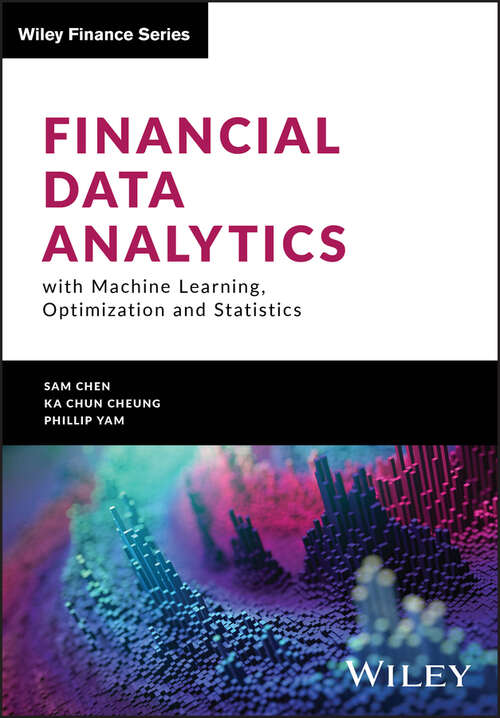Financial Data Analytics with Machine Learning, Optimization and Statistics (Wiley Finance)
By: and and
Sign Up Now!
Already a Member? Log In
You must be logged into Bookshare to access this title.
Learn about membership options,
or view our freely available titles.
- Synopsis
- An essential introduction to data analytics and Machine Learning techniques in the business sector In Financial Data Analytics with Machine Learning, Optimization and Statistics, a team consisting of a distinguished applied mathematician and statistician, experienced actuarial professionals and working data analysts delivers an expertly balanced combination of traditional financial statistics, effective machine learning tools, and mathematics. The book focuses on contemporary techniques used for data analytics in the financial sector and the insurance industry with an emphasis on mathematical understanding and statistical principles and connects them with common and practical financial problems. Each chapter is equipped with derivations and proofs—especially of key results—and includes several realistic examples which stem from common financial contexts. The computer algorithms in the book are implemented using Python and R, two of the most widely used programming languages for applied science and in academia and industry, so that readers can implement the relevant models and use the programs themselves. The book begins with a brief introduction to basic sampling theory and the fundamentals of simulation techniques, followed by a comparison between R and Python. It then discusses statistical diagnosis for financial security data and introduces some common tools in financial forensics such as Benford's Law, Zipf's Law, and anomaly detection. The statistical estimation and Expectation-Maximization (EM) & Majorization-Minimization (MM) algorithms are also covered. The book next focuses on univariate and multivariate dynamic volatility and correlation forecasting, and emphasis is placed on the celebrated Kelly's formula, followed by a brief introduction to quantitative risk management and dependence modelling for extremal events. A practical topic on numerical finance for traditional option pricing and Greek computations immediately follows as well as other important topics in financial data-driven aspects, such as Principal Component Analysis (PCA) and recommender systems with their applications, as well as advanced regression learners such as kernel regression and logistic regression, with discussions on model assessment methods such as simple Receiver Operating Characteristic (ROC) curves and Area Under Curve (AUC) for typical classification problems. The book then moves on to other commonly used machine learning tools like linear classifiers such as perceptrons and their generalization, the multilayered counterpart (MLP), Support Vector Machines (SVM), as well as Classification and Regression Trees (CART) and Random Forests. Subsequent chapters focus on linear Bayesian learning, including well-received credibility theory in actuarial science and functional kernel regression, and non-linear Bayesian learning, such as the Naïve Bayes classifier and the Comonotone-Independence Bayesian Classifier (CIBer) recently independently developed by the authors and used successfully in InsurTech. After an in-depth discussion on cluster analyses such as K-means clustering and its inversion, the K-nearest neighbor (KNN) method, the book concludes by introducing some useful deep neural networks for FinTech, like the potential use of the Long-Short Term Memory model (LSTM) for stock price prediction. This book can help readers become well-equipped with the following skills: To evaluate financial and insurance data quality, and use the distilled knowledge obtained from the data after applying data analytic tools to make timely financial decisions To apply effective data dimension reduction tools to enhance supervised learning To describe and select suitable data analytic tools as introduced above for a given dataset depending upon classification or regression prediction purpose The book covers the competencies tested by several professional examinations, such as the Predictive Analytics Exam offered by the Society of Actuaries, and the Institute and Faculty of Actu
- Copyright:
- 2024
Book Details
- Book Quality:
- Publisher Quality
- ISBN-13:
- 9781119863397
- Related ISBNs:
- 9781119863403, 9781119863373
- Publisher:
- Wiley
- Date of Addition:
- 10/19/24
- Copyrighted By:
- Sam Chen, Ka Chun Cheung, Phillip Yam.
- Adult content:
- No
- Language:
- English
- Has Image Descriptions:
- No
- Categories:
- Nonfiction, Computers and Internet, Business and Finance, Mathematics and Statistics
- Submitted By:
- Bookshare Staff
- Usage Restrictions:
- This is a copyrighted book.
Reviews
Other Books
- by Sam Chen
- by Ka Chun Cheung
- by Phillip Yam
- in Nonfiction
- in Computers and Internet
- in Business and Finance
- in Mathematics and Statistics
